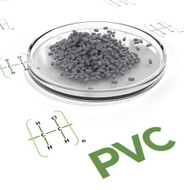PVC: Chemical Resistance, Durability and Flexibility
History
The development of polyvinyl chloride (PVC) began with the first report of vinyl chloride by Liebig and Regnault in 1835. Nearly four decades later, Baumann investigated the effect of light on the monomer, having observed the formation of a tough, white compound following light irradiation. Little progress was made in the following years until the early 1910s, when Fritz Klatte discovered a method for producing PVC. Commercial production began in the USA in the late 1920s. The use of phthalate esters as plasticizers came as an innovation following a patent disclosure in the 1930s, allowing for the synthesis of a technically useful material that could be processed at acceptable temperatures, resulting in soft and flexible products. By the start of World War II, emulsion and suspension technologies were widely used, with development further accelerated by the significant rubber shortage during the war.
After polypropylene (PP) and polyethylene (PE), PVC is the third most widely produced plastic. It is produced through the polymerization of the vinyl chloride monomer, typically via suspension polymerization (80% of production), which yields smaller particles compared to emulsion or bulk polymerization. In manufacturing, the monomer is mixed with water, an initiator, and other additives. To ensure uniform particle size distribution, the reactor is pressurized and continuously mixed to maintain the suspension, with cooling required due to the exothermic nature of the reaction.
Quick Highlights
- The vinyl chloride monomer was first reported in 1835, but methods to manufacture technically useful polyvinyl chloride (PVC) were achieved only in the 1930s.
- As the third most widely manufactured plastic after polypropylene (PP) and polyethylene (PE), PVC is synthesized via suspension polymerization of the vinyl chloride monomer.
Properties
PVC can be found in rigid (RPVC) or flexible forms, with the former typically used in construction applications such as pipes, doors, or windows. Other common applications include membership or bank cards and packaging. On the other hand, flexible forms are achieved through the use of plasticizers that soften PVC and enable its use in applications such as electric cable insulation, inflatable products, or rubber substitutes. PVC can also be combined with cotton or linen to produce canvases.
The unmodified PVC obtained from the polymerization process typically requires the incorporation of other agents to achieve the finished product. These agents include various additives, such as plasticizers, heat or UV stabilizers, impact or thermal modifiers, flame retardants, and biocides. The choice of additives depends on the required characteristics of the finished PVC product as well as cost-performance requirements.
Quick Highlights
- PVC comes in two forms: rigid (RPVC) and flexible. The former includes applications such as membership or bank cards, pipes, doors, and windows, while the latter includes applications such as electric cable insulation, inflatable products, or rubber substitutes.
- Unmodified PVC is mixed with additives based on the required characteristics and cost-performance requirements of the finished product.
Strength
PVC offers several advantages over other plastics. First and foremost, it is cost-effective and highly versatile in end-use and processing possibilities. It is naturally rigid but can be made more flexible with plasticizers. PVC is durable and exhibits good resistance to abrasions, impact, and outdoor weathering, though it has limited stress-cracking resistance.
Quick Highlights
- PVC is cost-effective and highly versatile in end-use and processing possibilities.
- It is durable and exhibits good resistance to abrasions, impact, and outdoor weathering, although it has limited stress-cracking resistance.

Thermal Properties
PVC demonstrates good dimensional stability at ambient temperatures. However, its heat distortion and softening temperatures are low, and the melting process is challenging due to poor thermal stability and high-shear issues. Additionally, PVC has limited thermal stability above 140°C (284°F), as degradation causes the release of toxic fumes, including hydrogen chloride. Moreover, PVC becomes brittle at low temperatures.
Quick Highlights
- PVC has low heat distortion and softening temperatures and poor thermal stability above 140°C (284°F), with degradation releasing toxic fumes such as hydrogen chloride.
- Low temperatures are also problematic, as PVC becomes brittle and loses its mechanical properties.
Chemical Resistance
PVC demonstrates excellent chemical resistance to acids, alkalis, oils, and most inorganic chemicals. It is also water-resistant, which enhances its performance across various applications. PVC has good electrical properties and high dielectric strength, making it ideal for electronic and electrical components. While the high chlorine content makes PVC naturally flame-resistant, burning it produces toxic fumes.
Quick Highlights
- PVC has excellent chemical stability against acids, alkalis, oils, and most inorganic chemicals; it is also water-resistant.
- It exhibits good electrical properties and high dielectric strength, ideal for applications in electrical and electronic components. Although PVC is naturally flame-resistant due to its high chlorine content, burning it produces toxic fumes.
Sustainability
The environmental considerations of PVC have been widely debated. Many governments, scientific organizations, and companies have recognized the hazards of PVC, leading to restrictions on its use. Throughout Europe, governments have limited certain uses of this material, and companies have implemented measures to reduce its consumption.
PVC belongs to a class of chemicals known as organochlorines, which have come under increased scrutiny due to their global distribution and severe hazards. Of particular concern are the immense volumes of chlorine-containing byproducts generated during vinyl chloride monomer production. Additionally, incineration of waste from this process generates even more byproducts, which are then released into the environment. These byproducts are highly persistent, bioaccumulative, and toxic, and are now regarded as global pollutants. Among them, dioxins are particularly concerning. Dioxins are among the most potent carcinogens ever tested in laboratories and are known human carcinogens.
The use of plasticizers and metal stabilizers also poses health and environmental risks. Phthalate plasticizers, the most common in PVC production, are not chemically linked to the polymer but rather mixed in during formulation, which allows them to leach into air and water over time. Phthalates are moderately persistent, moderately bioaccumulative, and have been shown to impact human reproduction.
The metals used as stabilizers include lead, cadmium, and organotin, which are toxic and are released into the environment during incineration. The mercury-based processes required for chlorine production also contribute, as mercury is a global pollutant known to have reproductive, developmental, and neurological impacts. Finally, PVC is extremely difficult to recycle due to the unique blend of additives used for different end-use products. While these disadvantages support restricting and reducing PVC consumption, it is worth noting that these hazards are limited to PVC, as it is the only plastic that contains chlorine or requires phthalate-based additives or metal stabilizers. Polypropylene (PP), polyethylene (PE), and thermoplastic polyurethane (TPU) are popular alternatives that offer similar properties without these hazards.
Quick Highlights
- Governments and companies have restricted PVC use and adopted measures to reduce its consumption due to associated hazards.
- PVC-related hazards include toxic byproducts from manufacturing and waste management, toxic additives in formulations, and toxic metal stabilizers. PVC is also inherently difficult to recycle due to its unique additive blend.
- These hazards are specific to PVC, as it is the only chlorine-based polymer that requires phthalate-based additives or metal stabilizers. Polypropylene, polyethylene, and thermoplastic polyurethane have become popular, non-toxic alternatives.
Browse durable PVC hex head plastic bolts made from polyvinyl chloride (UPVC) for corrosion-resistant fastening. Available in grey color and a range of M4, M5, and M6 sizes, these lightweight, non-metallic fasteners are ideal for assembly, outdoor use, and chemical-resistant applications.





